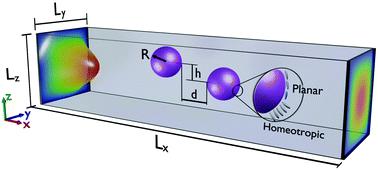当前位置:
X-MOL 学术
›
Soft Matter
›
论文详情
Our official English website, www.x-mol.net, welcomes your
feedback! (Note: you will need to create a separate account there.)
Directing the far-from-equilibrium assembly of nanoparticles in confined liquid crystals by hydrodynamic fields
Soft Matter ( IF 2.9 ) Pub Date : 2021-2-9 , DOI: 10.1039/d0sm02221g Stiven Villada-Gil 1, 2, 3, 4, 5 , Viviana Palacio-Betancur 6, 7, 8, 9 , Julio C. Armas-Pérez 10, 11, 12, 13, 14 , Juan J. de Pablo 6, 7, 8, 9, 15 , Juan P. Hernández-Ortiz 4, 5, 6, 16, 17
Soft Matter ( IF 2.9 ) Pub Date : 2021-2-9 , DOI: 10.1039/d0sm02221g Stiven Villada-Gil 1, 2, 3, 4, 5 , Viviana Palacio-Betancur 6, 7, 8, 9 , Julio C. Armas-Pérez 10, 11, 12, 13, 14 , Juan J. de Pablo 6, 7, 8, 9, 15 , Juan P. Hernández-Ortiz 4, 5, 6, 16, 17
Affiliation

|
The assembly of nematic colloids relies on long-range elastic interactions that can be manipulated through external stimuli. Confinement and the presence of a hydrodynamic field alter the defect structures and the energetic interactions between the particles. In this work, the assembly landscape of nanoparticles embedded in a nematic liquid crystal confined in a nanochannel under a pressure-driven flow is determined. The dynamics of the liquid crystal tensor alignment field is determined through a Poisson-Bracket framework, namely the Stark–Lubensky equations, coupled with the zero-Reynolds momentum equations and the liquid crystal Landau-de Gennes free energy functional. A second order semi-implicit time integration and a three-dimensional Galerkin finite element method are used to resolve flow and nematic fields under several conditions. In general, the zero Reynolds flow displaces the defects around the particles in the upstream direction and renders the surface anchoring ineffective when the flow strength dominates over the nematic elasticity. More importantly, the potential of mean force for particle assembly is non-monotonic independent of surface anchoring. Our results show that the confinement length scale determines the repulsion/attraction transition between colloids, while the flow strength modifies the static defect structure surrounding the particles and determines the magnitude of the energetic barrier for successful assembly. In the attractive regime, the particles move at different rates through the nematic until one particle eventually catches up with the other. This process occurs against or along the direction of flow depending on the flow strength. Ultimately, these results provide a template for engineering and controlling the transport and assembly of nanoparticles under far-from equilibrium conditions in anisotropic media.
中文翻译:

通过流体动力场引导纳米粒子在受限液晶中的远离平衡的组装
向列胶体的组装依赖于可通过外部刺激操纵的长距离弹性相互作用。约束和流体动力场的存在会改变缺陷结构和颗粒之间的能量相互作用。在这项工作中,确定了纳米颗粒在压力驱动下在纳米通道内嵌入的向列液晶中嵌入的纳米颗粒的组装情况。液晶张量取向场的动力学是通过泊松-布拉克特框架(即Stark-Lubensky方程,零雷诺动量方程和液晶Landau-de Gennes自由能泛函)确定的。使用二阶半隐式时间积分和三维Galerkin有限元方法来解析几种条件下的流场和向列场。通常,零雷诺流动会在上游方向上驱使颗粒周围的缺陷,并且当流动强度超过向列弹性时,使表面锚定失效。更重要的是,粒子聚集的平均力的潜力是非单调的,与表面锚固无关。我们的结果表明,限制长度尺度决定了胶体之间的排斥/吸引力转变,而流动强度则修饰了围绕颗粒的静态缺陷结构,并确定了成功组装所需的能量屏障的大小。在吸引人的情况下,粒子以不同的速率穿过向列,直到一个粒子最终赶上另一个粒子。取决于流动强度,该过程逆着流动方向或沿着流动方向发生。最终,
更新日期:2021-03-03
中文翻译:

通过流体动力场引导纳米粒子在受限液晶中的远离平衡的组装
向列胶体的组装依赖于可通过外部刺激操纵的长距离弹性相互作用。约束和流体动力场的存在会改变缺陷结构和颗粒之间的能量相互作用。在这项工作中,确定了纳米颗粒在压力驱动下在纳米通道内嵌入的向列液晶中嵌入的纳米颗粒的组装情况。液晶张量取向场的动力学是通过泊松-布拉克特框架(即Stark-Lubensky方程,零雷诺动量方程和液晶Landau-de Gennes自由能泛函)确定的。使用二阶半隐式时间积分和三维Galerkin有限元方法来解析几种条件下的流场和向列场。通常,零雷诺流动会在上游方向上驱使颗粒周围的缺陷,并且当流动强度超过向列弹性时,使表面锚定失效。更重要的是,粒子聚集的平均力的潜力是非单调的,与表面锚固无关。我们的结果表明,限制长度尺度决定了胶体之间的排斥/吸引力转变,而流动强度则修饰了围绕颗粒的静态缺陷结构,并确定了成功组装所需的能量屏障的大小。在吸引人的情况下,粒子以不同的速率穿过向列,直到一个粒子最终赶上另一个粒子。取决于流动强度,该过程逆着流动方向或沿着流动方向发生。最终,











































 京公网安备 11010802027423号
京公网安备 11010802027423号